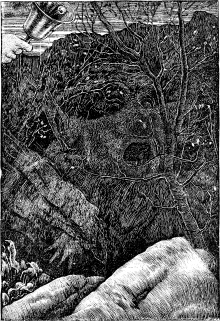The Hunting of the Snark
.jpg) Cover of first edition | |
| Author | Lewis Carroll |
|---|---|
| Illustrator | Henry Holiday |
| Cover artist | Henry Holiday |
| Country | United Kingdom |
| Language | English |
| Genre | Nonsense poetry |
| Publisher | Macmillan Publishers |
Publication date | 29 March 1876 |
| OCLC | 2035667 |
| Text | The Hunting of the Snark at Wikisource |
The Hunting of the Snark (An Agony in 8 Fits) is a poem written by English writer Lewis Carroll. It is typically categorised as a nonsense poem. Written from 1874 to 1876, the poem borrows the setting, some creatures, and eight portmanteau words from Carroll's earlier poem "Jabberwocky" in his children's novel Through the Looking Glass (1871).
Henry Holiday, the illustrator of the poem, thought of it as a "tragedy".[lower-alpha 1]
The plot follows a crew of ten trying to hunt the Snark, an animal which may turn out to be a highly dangerous Boojum. The only one of the crew to find the Snark quickly vanishes, leading the narrator to explain that it was a Boojum after all. The poem is dedicated to young Gertrude Chataway, whom Carroll met at the English seaside town Sandown in the Isle of Wight in 1875. Included with many copies of the first edition of the poem was Carroll's religious tract, An Easter Greeting to Every Child Who Loves "Alice".
The Hunting of the Snark was published by Macmillan in the United Kingdom in late March 1876, with illustrations by Henry Holiday. It had mixed reviews from reviewers who found it strange. The first printing of The Hunting of the Snark consisted of 10,000 copies. There were two reprintings by the conclusion of the year; in total, the poem was reprinted 17 times between 1876 and 1908. Carroll often denied knowing the meaning behind the poem; however, in an 1896 reply to one letter, he agreed with one interpretation of the poem as an allegory for the search for happiness. Scholars have found various meanings in the poem, among them existential angst, an allegory for tuberculosis, and a mockery of the Tichborne case. The Hunting of the Snark has been alluded to in various works and has been adapted for musicals, opera, plays, and music.
Plot
Setting
The Hunting of the Snark shares its fictional setting with Lewis Carroll's earlier poem "Jabberwocky" published in his children's novel Through the Looking-Glass (1871).[2] Eight nonsense words from "Jabberwocky" appear in The Hunting of the Snark: bandersnatch, beamish, frumious, galumphing, jubjub, mimsiest (which previously appeared as mimsy in "Jabberwocky"), outgrabe and uffish.[3] In a letter to the mother of his young friend Gertrude Chataway, Carroll described the domain of the Snark as "an island frequented by the Jubjub and the Bandersnatch—no doubt the very island where the Jabberwock was slain."[4]
Characters
The crew consists of ten members, whose descriptions all begin with the letter B:[5] a Bellman, the leader; a "Boots", who is the only member of the crew without an illustration;[6] a maker of Bonnets and Hoods; a Barrister, who settles arguments among the crew; a Broker, who can appraise the goods of the crew; a Billiard-marker, who is greatly skilled; a Banker, who possesses all of the crew's money; a Butcher, who can only kill beavers; a Beaver, who makes lace and has saved the crew from disaster several times; and a Baker, who can only bake wedding cake, forgets his belongings and his name, but possesses courage.[7]
 Bellman
Bellman maker of Bonnets
maker of Bonnets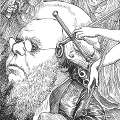 Barrister
Barrister Broker
Broker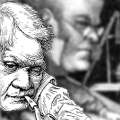 Billiard-Marker
Billiard-Marker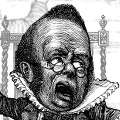 Banker
Banker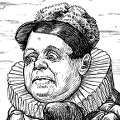 Butcher
Butcher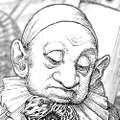 Baker
Baker Beaver
Beaver
Summary
 |
|
| Problems playing this file? See media help. | |

After crossing the sea guided by the Bellman's map of the Ocean—a blank sheet of paper—the hunting party arrive in a strange land, and the Bellman tells them the five signs by which a Snark can be identified. The Bellman warns them that some Snarks are highly dangerous Boojums; on hearing this, the Baker faints. Once revived, the Baker recalls that his uncle warned him that if the Snark turns out to be a Boojum, the hunter will "softly and suddenly vanish away, and never be met with again."[8] The Baker confesses that this possibility terrifies him.
The hunt begins: "They sought it with thimbles, they sought it with care; / They pursued it with forks and hope; / They threatened its life with a railway-share; / They charmed it with smiles and soap."[9] Along the way, the Butcher and Beaver, previously mutually wary, become fast friends after the Butcher gives the beaver a lesson on math and zoology. The Barrister, meanwhile, sleeps, and dreams of witnessing a court trial of a pig accused of deserting its sty.
During the hunt, the Banker gets attacked by a bandersnatch, and loses his sanity after trying to bribe the creature.
The Baker rushes ahead of the party, and calls out that he has found a snark, but when the others arrive, he has mysteriously disappeared, leading the narrator to explain: "For the Snark was a Boojum, you see."[10]
Development
Girt with a boyish garb for boyish task
Eager she wields her spade: yet loves as well
Rest on a friendly knee, intent to ask
The tale he loves to tell.
Rude spirits of the seething outer strife,
Unmeet to read her pure and simple spright,
Deem, if you list, such hours a waste of life
Empty of all delight!
Chat on, sweet Maid, and rescue from annoy
Hearts that by wiser talk are unbeguiled.
Ah, happy he who owns that tenderest joy,
The heart-love of a child!
Away fond thoughts, and vex my soul no more!
Work claims my wakeful nights, my busy days—
Albeit bright memories of that sunlit short
Yet haunt my dreaming gaze!
—Lewis Carroll, The Hunting of the Snark
Two explanations of which event in Carroll's life gave rise to The Hunting of the Snark have been offered. Biographer Morton N. Cohen connects the creation of The Hunting of the Snark with the illness of Carroll's cousin and godson, the twenty-two-year-old Charlie Wilcox.[11] On 17 July 1874, Carroll travelled to Guildford, Surrey, to care for him for six weeks, while the young man struggled with tuberculosis.[12][13] The next day, while taking a walk in the morning after only a few hours of sleep, Carroll thought of the poem's final line: "For the Snark was a Boojum, you see."[14] Fuller Torrey and Judy Miller suggest that the event that inspired the poem was the sudden death of Carroll's beloved uncle, Robert Wilfred Skeffington Lutwidge, caused by a violent mentally-ill patient in 1873, during Lutwidge's time as an inspector of lunatic asylums. They support their analysis with parts of the poem, such as the Baker's uncle's advice to seek the Snark with thimbles, forks, and soap, which, according to Torrey and Miller, were all items the lunatic asylum inspectors checked during their visits.[15]
To illustrate the poem Carroll chose Henry Holiday, whom he had met in 1869[16] or 1870.[17] At the time Carroll approached him to ask if he could create three illustrations for the poem, Carroll had three 'fits', as he called the parts of his poem—fit can mean either canto or convulsion[18]—completed: "The Landing", "The Hunting", and "The Vanishing".[17] He intended to title it The Boojum and include it in his fantasy novel Sylvie and Bruno, which was unfinished at the time.[17] However, in late October 1875, Carroll thought about having it published during Christmas; this proved impossible, as the wood engraving for the illustrations needed three months to be complete.[19] By the time Holiday had completed the sketches and sent them to Carroll, Carroll had already created a new fit requiring an illustration. They worked this way until Holiday had created nine illustrations as well as the front cover and the back cover of the book.[16] The completed poem comprised 141 stanzas of four lines each,[20] with internal rhymes in the first and third lines of irregular stanzas appearing in the poem from the second fit onwards.[21] Holiday and Carroll additionally had some disagreements on the artwork. Carroll initially objected to Holiday's personification of hope and care, but agreed to the change, when Holiday explained that he had only intended to add another layer of meaning to the word "with".[16] However, Carroll refused his illustration of the Boojum, preferring that the creature go without a depiction,[22] and made him change his initial portrayal of the Broker, as it could be perceived as anti-semitic.[6]
There is no depiction of the Snark. However, based on a draft[23] by Lewis Carroll, the Snark was allowed to show up in an illustration by Henry Holiday, where it appeared in a dream of the Barrister. As for the word "Snark", Carroll did not give it any meaning. The word "snarking" had been used in 1866 to describe a sound.[24]
First publishing
Upon the printing of the book on 29 March 1876, Carroll gave away eighty signed copies to his favourite young friends; in a typical fashion, he signed them with short poems, many of them acrostics of the child's name.[19] He dedicated The Hunting of the Snark to Chataway, whom he had befriended in summer 1875 at the English seaside town Sandown on the Isle of Wight.[25] He finished the dedication a month after befriending her, a double acrostic poem that not only spelled out her name, but contained a syllable of her name in the first line of each stanza.[26] The stanza of his first draft concluded "Rest on a friendly knee, the tale to ask / That he delights to tell."[4] The poem was printed in The Hunting of the Snark with permission from Chataway's mother.[4]
Included with many copies of the first edition of The Hunting of the Snark was Carroll's three-page, religious tract to his young readers, An Easter Greeting to Every Child Who Loves "Alice".[27] Largely written on 5 February 1876, An Easter Greeting explores the concept of innocence and eternal life through biblical allusions and literary allusions to Romantic writers William Blake and William Wordsworth.[11][27] Gardner suggests that Carroll included the tract as a way of balancing the dark tone of the poem.[27] Scholar Selwyn Goodacre speculates that, as many copies of first-edition of the poem contain the tract, there is a possibility that all first editions originally had a copy of An Easter Greeting.[28]
Reception and legacy
The first printing of The Hunting of the Snark consisted of 10,000 copies.[29] By the conclusion of 1876, it had seen two reprints, with a total of 18,000[30] or 19,000 copies circulating.[31] In total, the poem was reprinted seventeen times between 1876 and 1908.[30]
The Hunting of the Snark received largely mixed reviews from Carroll's contemporary reviewers.[13] The Academy's Andrew Lang criticised Carroll's decision to use poetry instead of prose and its too appealing title.[13] The Athenaeum described it as "the most bewildering of modern poetry," wondering "if he has merely been inspired to reduce to idiotcy as many readers and more especially reviewers, as possible."[13] According to Vanity Fair, Carroll's work had progressively worsened after Alice's Adventures in Wonderland (1865), with The Hunting of the Snark being the worst of his works and "not worthy [of] the name of nonsense".[13] While The Spectator wrote that the poem's final line had the potential to become a proverb, it criticised the poem as "a failure" that might have succeeded with more work from the author.[13] The Saturday Review wrote that the poem offered "endless speculation" as to the true identity of the snark, although the unnamed reviewer felt that the familiar nature of Carroll's nonsense weakened its effect for the reader.[13] Conversely, The Graphic praised the poem as a welcome departure from the Alice books, and called it "a glorious piece of nonsense," that could appeal to all Alice fans.[13]
"The Hunting of the Snark" has in common some elements with Carroll's other works. It shares its author's love of puns on the word 'fit' with Alice's Adventures in Wonderland,[32] and mentions of "candle-ends" and "toasted cheese" with his supernatural poem Phantasmagoria.[33] Additionally all three works include the number "42".[34] Another of Carroll's children's novels, Sylvie and Bruno Concluded (1893) makes a reference to the Boojum.[35]
Other illustrators of The Hunting of the Snark include Peter Newell (1903), Edward A. Wilson (1932), Mervyn Peake (1941), Aldren Watson (1952), Tove Jansson (1959), Helen Oxenbury (1970), Byron Sewell (1974), John Minnion (1974), Harold Jones (1975), Ralph Steadman (1975), Quentin Blake (1976), Frank Hinder (1989) and Brian Puttock (1997).[28]
Cultural impact
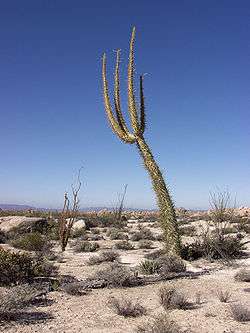
The Hunting of the Snark has seen various adaptations into musicals, opera, theatre, plays, and music,[28] including one for trombone by Norwegian composer Arne Nordheim (1975)[37] and a jazz rendition (2009)[38] The poem has also inspired literature, such as Jack London's The Cruise of the Snark (1911),[28] the science-fiction short story "Chaos, Coordinated" (1947) by John MacDougal,[39] and Elsabeth Huxley's With Forks and Hope (1964).[40] American author Edith Wharton (1862-1937) was fond of the poem as a child.[39]
Additionally, it has also been alluded to in fiction, such as Perelandra (1943) by C.S. Lewis;[41] television, such as "The Soul of Genius" episode of the British TV crime drama Lewis;[42] court rulings, such as in Parhat v. Gates (2008);[43] a phenomenon in superfluidity;[44] graph theory;[45] geography, as a Snark Island and Boojum Rock exist in the Andaman and Nicobar Islands in the Bay of Bengal;[46] Japanese animation, such as Ghost Hound (2007–08);[47] and in video games, such as Half-Life (1998)[48] and American McGee's Alice (2000).[49]
Composer Tim Hodgkinson referenced the Snark and Boojum in the song "Nine Funerals of the Citizen King", from the album Legend by Henry Cow:[50]
That the Snark was a Boojum / All can tell
Analysis
Various themes have been suggested by scholars. According to biographer Florence Becker Lennon, the poem's "motif of loss of name or identity" is typical of Carroll's work.[52] Richard Kelly writes that the poem contains a "theme of annihilation."[53] Furthermore, Edward Guiliano feels that the Snark is within the nonsense tradition of Thomas Hood and, especially, W. S. Gilbert, the librettist of the famous Gilbert and Sullivan team. According to him, a case can be made for a direct influence of Gilbert's Bab Ballads on The Hunting of the Snark, based on the fact that Carroll was well-acquainted with the comic writing and the theatre of his age.[54]
In response to various letters asking for the meaning of the poem, Carroll often replied that he did not know.[55] However, in an 1896 reply to one letter, he agreed with one interpretation of the poem as an allegory for the search for happiness.[56] Widely varying interpretations of The Hunting of the Snark have been suggested: an allegory for tuberculosis,[57] a mockery of the Tichborne case, a satire of the controversies between religion and science, the repression of Carroll's sexuality, and a piece against vivisection, among others.[58] According to Cohen, the poem represents a "voyage of life", with the Baker's disappearance caused by his violation of the laws of nature by hoping to unravel its mysteries.[59] Lennon sees The Hunting of the Snark as "a tragedy of frustration and bafflement," comparable to British actor Charlie Chaplin's early comedies.[60] According to Kelly, The Hunting of the Snark is "Carroll's comic rendition of his fears of disorder and chaos, with the comedy serving as a psychological defense against the devastating idea of personal annihilation."[61] Kelly writes that the Bellman's Rule of Three and starting each character's name with the letter B are "notable attempts to create a sense of order and meaning out of chaos."[5] Martin Gardner sees the poem as dealing with existential angst,[62] and states that the Baker may be Carroll's satire of himself, pointing to the fact that the Baker was named after a beloved uncle, as was Carroll, and that the two were around the same age at the time of the writing of the poem.[63] Alternatively, Larry Shaw of the fan magazine Inside and Science Fiction Advertiser suggests that the Boots, being the Snark, actually murdered the Baker.[64][65]
See also
- Snark
- Snark, a 1974 text game inspired by the poem.
- The Hunting of the Snark Musical, written by Mike Batt based on the original nonsense poem.
Notes
References
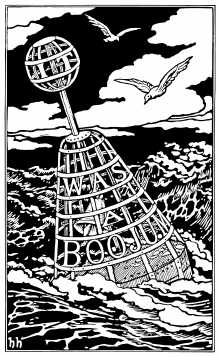
- ↑ "Lot 646: Carroll, Lewis [Charles Lutwidge Dodgson] The Hunting Of The Snark: An Agony In Eight Fits. Macmillan, 1876". Sotheby's. 15 July 2014. Retrieved 14 January 2016.
- ↑ Lennon 1962, p. 176.
- ↑ Lennon 1962, p. 242.
- 1 2 3 Gardner 2006, p. 7.
- 1 2 3 Kelly 1990, p. 67.
- 1 2 Gardner 2006, p. 17.
- ↑ Carroll 1898, pp. 8-14.
- ↑ Carroll 1898, p. 23.
- ↑ Carroll 1898, p. 32.
- ↑ Carroll 1898, p. 53.
- 1 2 Cohen 1995, p. 403.
- ↑ Cohen 1995, pp. 403–404.
- 1 2 3 4 5 6 7 8 Cohen, Morton N. (1976). "Hark the Snark". In Guilano, Edward. Lewis Carroll Observed. New York: Clarkson N. Potter, Inc. pp. 92–110. ISBN 0-517-52497-X.
- ↑ Cohen 1995, p. 404.
- ↑ E. Fuller Torrey; Judy Miller (2001). The Invisible Plague: The Rise of Mental Illness from 1750 to the Present. New Brunswick: Rutgers University Press. pp. 91–92. ISBN 0-8135-3003-2.
- 1 2 3 Holiday, Henry. "Excepts from Henry Holiday's Reminiscences of My Life". In Gardner, Martin. The Annotated Hunting of the Snark: The Definitive Edition. New York: W. W. Norton & Company, Inc. pp. 113–115. ISBN 978-0-393-06242-7.
- 1 2 3 Clark 1979, pp. 196–7.
- ↑ Gardner 2006, p. 11.
- 1 2 Gardner 2006, p. xxx.
- ↑ Kelly 1990, p. 22.
- ↑ Lennon 1962, p. 240-5.
- ↑ Clark 1979, pp. 196-97.
- ↑ http://www.ipernity.com/doc/goetzkluge/32765945 shows a redrawn image from a concept draft by C. L. Dodgson (a.k.a. Lewis Carroll). The drawing was part of a lot consisting of an 1876 edition of the "Hunting of the Snark" and a letter (dated 1876-01-04) by Dodgson to Henry Holiday. The lot was auctioned by Doyle New York (Rare Books, Autographs & Photographs - Sale 13BP04 - Lot 553) offered in November 2013.
- ↑ Anonymous (29 September 1866). "Sermons in Stones". Notes and Queries. series 3. 10: 248. doi:10.1093/nq/s3-X.248.248-f.
- ↑ Gardner 2006, p. 5.
- ↑ Gardner 2006, p. 5-6.
- 1 2 3 Gardner 2006, p. 73.
- 1 2 3 4 Greenarce, Selwyn (2006) [1876]. "The Listing of the Snark". In Martin Gardner. The Annotated Hunting of the Snark ("Definitive Edition" ed.). W. W. Norton. p. 117–147. ISBN 0-393-06242-2.
- ↑ Clark 1979, p. 198-9.
- 1 2 Williams, Sidney Herbert; Madan, Falconer (1979). Handbook of the literature of the Rev. C.L. Dodgson. Folkestone, England: Dawson. p. 68. ISBN 9780712909068. OCLC 5754676.
- ↑ Clark 1979, pp. 198–9.
- ↑ Gardner 2006, p. 12.
- ↑ Gardner 2006, p. 22.
- ↑ Gardner 2006, p. 37.
- ↑ Gardner 2006, p. 34.
- ↑ Gardner 2006, p. 35.
- ↑ "Nordheim list of works". Arnenordheim.com. Retrieved 7 January 2012.
- ↑ All About Jazz (13 December 2009). "NYNDK | The Hunting of the Snark". Allaboutjazz.com. Retrieved 7 January 2012.
- 1 2 Gardner 2006, p. 16.
- ↑ Gardner 2006, p. 42.
- ↑ Lewis, C.S. (1943). Perelandra. Cosmic Trilogy. London: The Bodley Head. p. 14.
- ↑ Lacob, Jace (2012-07-05). "‘Inspector Lewis’ on PBS's 'Masterpiece Mystery’: TV's Smartest Sleuths". The Daily Beast. Retrieved 2012-07-09.
- ↑ Bill Mears (30 June 2008). "Court cites nonsense poem in ruling for Gitmo detainee". CNN. Archived from the original on 22 August 2012. Retrieved 22 August 2012.
A federal appeals court has slammed the reliability of U.S. government intelligence documents, saying just because officials keep repeating their assertions does not make them true.
- ↑ N. David Mermin (1990). Boojums all the way through: communicating science in a prosaic age. Cambridge University Press. p. xii. ISBN 0-521-38880-5.
- ↑ Gardner, Martin (1976), "Mathematical Games", Scientific American, 4 (234): 126–130
- ↑ Gardner 2006, p. xxv.
- ↑ "For the Snark was a Boojum, you see". Ghost Hound. Season 1. Episode 13 (in Japanese). 2008. WOWOW.
- ↑ "Half-Life enemies". GameSpy. IGN Entertainment. Retrieved 2013-10-11.
- ↑ "Gameinfo: Enemies". Down the Rabbit Hole. Gamespy. Archived from the original on 2009-04-06. Retrieved 2014-06-02.
- ↑ "Henry Cow - The Nine Funerals of the Citizen King Lyrics | SongMeanings". SongMeanings. Retrieved 2017-05-07.
- ↑ Gardner 2006, p. 70.
- ↑ Lennon 1962, p. 243.
- ↑ Kelly 1990, p. 27.
- ↑ Guiliano, Edward (1987). "Lewis Carroll, Laughter and Despair, and the Hunting of the Snark". In Harold Bloom. Lewis Carroll. New York: Chelsea House. p. 124.
- ↑ Gardner 2006, p. xxxvii.
- ↑ Gardner 2006, p. xxxviii.
- ↑ Gardner 2006, p. xxiv.
- ↑ Cohen 1995, pp. 410.
- ↑ Cohen 1995, p. 400-1.
- ↑ Lennon 1962, p. 241.
- ↑ Kelly 1990, pp. 66–7.
- ↑ Gardner 2006, p. xxxvi.
- ↑ Gardner 2006, p. 37-8.
- ↑ Shaw, Larry (September 1956). "The Baker Murder Case". Inside and Science Fiction Advertiser: 4–12.
- ↑ Gardner 2006, p. 69.
Sources
- Carroll, Lewis (2006) [1876]. The Annotated Hunting of the Snark. Edited with notes by Martin Gardner, illustrations by Henry Holiday and others, introduction by Adam Gopnik ("Definitive Edition" ed.). W. W. Norton. ISBN 0-393-06242-2.
- Carroll, Lewis (1898). The Hunting of the Snark, an Agony in Eight Fits. Illustrations by Henry Holiday. The Macmillan Company. Retrieved 17 January 2008.
- Clark, Anne (1979). Lewis Carroll: A Life. New York: Schocken Books. ISBN 978-0-8052-3722-1. OCLC 4907762.
- Cohen, Morton N. (1995). Lewis Carroll: A Biography. Macmillan. ISBN 0-333-62926-4.
- Kelly, Richard (1990). "Poetry: Approaching the Void". Lewis Carroll. Boston: G. K. Hall & Co. ISBN 978-0-8057-6988-3.
- Lennon, Florence Becker (1962). The Life of Lewis Carroll: Victoria Through the Looking-Glass. New York: Collier Books. ISBN 0-486-22838-X. OCLC 656464.
Further reading
- Faimberg, Haydée (2005) [1977]. "The Telescoping of Generations: 'The Snark was a Boojum'". Reading Lewis Carroll. pp. 117–128. ISBN 1-58391-752-7.
- Schweitzer, Louise (2012). "In about one fourth of Schweitzer's doctoral thesis, several chapters are dedicated to The Hunting of the Snark (page 197 to 257)". One Wild Flower. London: Austin & Macauley. ISBN 978-1-84963-146-4.
- Soto, Fernando (Autumn 2001). "The Consumption of the Snark and the Decline of Nonsense: A Medico-Linguistic Reading of Carroll’s ‘Fitful Agony’". The Carrollian (8): 9–50. ISSN 1462-6519.
External links
| Wikimedia Commons has media related to The Hunting of the Snark. |
| Wikisource has original text related to this article: |
| Wikiquote has quotations related to: The Hunting of the Snark |
- The Hunting of the Snark downloadable formats from Project Gutenberg
-
 The Hunting of the Snark public domain audiobook at LibriVox
The Hunting of the Snark public domain audiobook at LibriVox - The Hunting of the Snark in HTML with original illustrations (mirrored and extended version with line numbering, Carroll's original dedication to Gertrude Chataway and Carroll's Easter greeting)
- The Hunting of the Snark in BD form, with commentary for each stanza
- A catalogue raisonné of illustrated Snarks
- John Tufail: The Illuminated Snark. An enquiry into the relationship between text and illustration in The Hunting of the Snark. 2004, 36 pages., (pg. 29: Examples for the usage of simulacra)
- Catalogue of the main illustrated editions of The Hunting of the Snark https://sites.google.com/site/lewiscarrollillustratedsnark/home?pli=1
- High resolution scans of Henry Holiday's illustrations from an original 1876 edition
- "The Hunting of the Snark di Lewis Carroll nella traduzione di Adriano Orefice." (PDF) (in Italian). Il Covile. 2012. Retrieved 9 March 2013.
- Armenian translation of the poem









